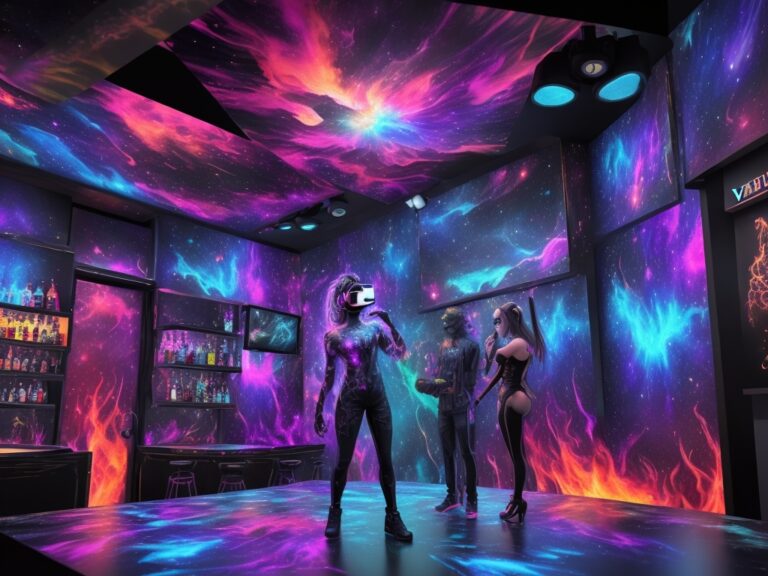Can Virtual Reality Cause Seizures?
Key Takeaways:
- Virtual Reality (VR) can cause seizures in individuals with epileptic conditions or sensitivity to rapidly changing light patterns. Flashing lights and exposure to overwhelming visual stimulation in VR can increase the chance of seizure onset and pose risks for photosensitive epilepsy.
- Manufacturers discourage the use of VR for individuals with epilepsy and provide warnings regarding the potential risks. Companies like Oculus have issued cautionary statements and are developing software updates to reduce the risk of seizures associated with their VR devices.
- Understanding seizures, avoiding flashing lights and patterns, and limiting exposure to overwhelming visual stimuli are important protective measures that can help mitigate the dangers of VR for individuals with epilepsy.
- The link between Oculus VR devices and photosensitive epilepsy has been established, emphasizing the need for cautious use. Users are advised to follow manufacturer guidelines, take breaks while using VR, and adjust settings to minimize the risk of triggering seizures.
- Gamma oscillations, which are rapid neural oscillations, have been found to trigger seizures when exposed to certain black and white bar patterns. Understanding the role of gamma oscillations can aid in developing strategies to manage epilepsy in the context of virtual reality.
- In summary, it is crucial to understand and manage epilepsy when using virtual reality. By being aware of the potential risks, adhering to manufacturer guidelines, and having an understanding of seizures and gamma oscillations, individuals can enjoy VR experiences while minimizing the risk of triggering seizures.
The Potential Risks of Virtual Reality
Virtual reality has opened up new realms of possibilities, but alongside its innovative nature, there are potential risks that deserve attention. In this section, we will explore two crucial aspects: the impact of virtual reality on individuals with epileptic conditions or sensitivity to rapidly changing light, and the warnings and discouragement from manufacturers themselves. By shedding light on these concerns, we can better understand the potential risks associated with virtual reality and make informed decisions regarding its usage.
Impact on Individuals with Epileptic Conditions or Sensitivity to Rapidly Changing Light
Virtual reality (VR) technology has the potential to affect individuals with epilepsy or sensitivity to rapidly changing light. Epilepsy is a neurological disorder marked by recurrent seizures. Flashing lights and patterns can trigger seizures in those with epilepsy.
VR experiences involve rapid changes in lighting and intense visual effects. This increases the risk of seizures for those with photosensitive epilepsy. Plus, individuals wearing headsets don’t have control over the environment, raising the chances of seizure induction.
Regarding Oculus VR devices, there’s been a link observed between their use and photosensitive epilepsy. Oculus issued a warning and released a software update to address this. They advise users to take breaks during VR sessions and consult their healthcare provider if they have a history of seizures.
Understanding the mechanisms behind seizure triggering is key for managing epilepsy in virtual reality. One mechanism may be gamma oscillations, rhythmic neural activities around 30-100 Hz. Research shows that black-and-white bar patterns on screens can induce seizures in people with photosensitive epilepsy.

Manufacturers’ Warnings and Discouragement
Manufacturers of virtual reality devices are raising awareness about the potential risks posed to individuals with epilepsy or sensitivity to rapidly changing light. Warnings have been issued to inform users and encourage them to prioritize their health and safety when using such devices.
- The visual stimulation in virtual reality can increase the risk of seizures for those with epilepsy.
- It can also trigger photosensitive epilepsy, a condition in which seizures are caused by specific visual stimuli.
- Rapidly flashing lights or patterns may be difficult for individuals with epilepsy to turn away from.
- Oculus, a leading manufacturer, has acknowledged the link between their products and photosensitive epilepsy.
- They have issued warnings and created software updates to address these issues and keep users safe.
It’s essential to consider these warnings and take extra care when using virtual reality. Although it can bring unique experiences and benefits, one’s health and safety should always come first.
Manufacturers are doing their part to educate consumers about the risks associated with virtual reality. Through their warnings and software updates, they’re demonstrating their commitment to ensuring user safety.
Understanding Seizures and their Causes
Seizures can be a complex and concerning occurrence, and understanding their causes is crucial. In this section, we’ll explore the different factors that contribute to seizures. From delving into the definition of seizures to examining their common causes, we’ll also uncover the role of flashing lights and patterns in triggering these events. Let’s unravel the intricacies of seizures and gain a deeper understanding of their underlying causes.
Definition of Seizures
Seizures refer to sudden, uncontrolled electrical disturbances in the brain. These disruptions can cause abnormal movements, loss of consciousness, changes in behavior or sensations, and other manifestations. They are usually a symptom of an underlying neurological condition or disorder. Different types exist, based on their characteristics and the areas of the brain they affect.
Causes of seizures vary. They may be from genetic factors or developmental abnormalities in the brain. Or, they can be triggered by external factors like head injuries or infections. One common trigger is exposure to rapidly changing light patterns or flashing lights, inducing abnormal electrical activity in the brain.
Virtual reality (VR) technology has been found to pose potential risks for people with epilepsy, specifically those sensitive to rapidly changing light or have photosensitive epilepsy. The immersive nature of VR experiences can lead to overwhelming visual stimulation, which can increase the risk of triggering a seizure. Oculus users may have difficulty turning away from flashing lights or patterns due to the nature of the technology.
Evidence suggests a link between Oculus use and photosensitive epilepsy. The manufacturer has issued warnings and provided software updates to reduce the likelihood of inducing seizures in susceptible individuals. Therefore, users should exercise caution and follow manufacturers’ advice when using VR tech.
Gamma oscillations play a role in seizure triggering too. These are rhythmic electrical activities in the brain, occurring within specific frequency ranges. Certain visual stimuli, such as black and white bar patterns, can elicit gamma oscillations and potentially trigger seizures in susceptible individuals.
Common Causes of Seizures
Seizures can be caused by various factors. To manage epilepsy, it’s important to understand these common causes. One is rapidly changing light and visual stimulation, which can trigger seizures in those with epilepsy or sensitivity to such stimuli.
Manufacturers of virtual reality (VR) devices often warn users of the potential risks. It’s important to comprehend the danger that VR poses for epilepsy, as the overwhelming visual stimulation can increase the risk of photosensitive epilepsy. Additionally, it can be hard to turn away from flashing lights in VR, further heightening the risk of seizure. Oculus, a prominent VR manufacturer, has implemented warning systems and software updates to reduce this risk. It’s important to consider the potential benefits of VR alongside the manufacturer’s advice to ensure safe usage for individuals prone to seizures.
Gamma oscillations, high-frequency electrical activity in the brain, can also trigger seizures. Certain patterns, like black and white bar patterns in VR, have been found to trigger seizures in susceptible individuals. The synchronization of these gamma oscillations with external stimuli can lead to epileptic episodes. So, understanding this connection between certain visual patterns and seizure occurrence is essential in assessing the risks of VR.

In summary, common causes of seizures include exposure to rapidly changing light and visual stimulation, which can trigger epileptic episodes. VR technology amplifies these risks due to its overwhelming visual stimulation and an individual’s inability to look away from flashing lights. Oculus has acknowledged this risk and provided warnings and software updates. Furthermore, understanding gamma oscillations and their synchronization with certain visual patterns helps identify triggers for seizures. By considering these common causes and taking necessary precautions, individuals prone to seizures can better manage their epilepsy when engaging with VR experiences.
Role of Flashing Lights and Patterns
Flashing lights and patterns can be risky when it comes to virtual reality for people with epilepsy or sensitivity to quick light changes. Seizures are caused by many things – including flashing lights. When in virtual reality, individuals may not be able to turn away from such light patterns, making them more likely to have a seizure. Therefore, it is important to think about the risks of flashing lights and patterns in virtual reality.
Seizures are abnormal electrical activity in the brain that cause temporary issues with behavior or motor functions. While many things can cause seizures, flashing lights are often a trigger. The visual stimulation in virtual reality may cause gamma oscillations in the brain, leading to seizures in those susceptible. This means it is important to consider the effects of flashing lights and patterns in virtual reality design.
Black and white bar patterns may especially be dangerous for those with photosensitive epilepsy. Gamma oscillations caused by these patterns can disrupt brain activity and cause a seizure. Therefore, manufacturers and developers of virtual reality should pay attention to the design elements involving flashing lights and patterns. Following safety measures and guidelines put forth by medical professionals can help limit risks for all users.
Virtual reality can be fun and exciting – but the danger of flashing lights and overwhelming stimulation can easily turn that joyride into a seizure-inducing roller coaster!
The Danger of Virtual Reality for Epilepsy
Virtual reality has become a captivating escape into another world, but for those with epilepsy, it can pose serious risks. In this section, we delve into the danger of virtual reality for epilepsy, exploring overwhelming visual stimulation, an increased risk for photosensitive epilepsy, and the potential inability to turn away from flashing lights. Brace yourself for a startling look at the potential hazards that virtual reality may present for individuals with epilepsy.
Overwhelming Visual Stimulation in VR
Studies have shown that virtual reality (VR) can be overwhelming visually. This can be risky for those with epilepsy or sensitivity to light changes. Flashing lights and patterns used in VR can trigger seizures in susceptible people. Manufacturers of VR devices have warned against using their products for those with epilepsy, stressing the importance of understanding the potential risks of overwhelming visuals.
- VR can be intense visually, immersing users in a virtual environment.
- It has been found to be dangerous for those with epileptic conditions or sensitivity to light changes.
- Flashing lights and rapid visual stimuli in VR can lead to seizures.
- Oculus, one of the leading makers of VR, released a software update with options to reduce or eliminate flashing lights and patterns.
- Manufacturers advise getting advice from healthcare professionals before using.
- Despite risks, VR has benefits for education, entertainment, and therapy.
The risk of overwhelming visuals isn’t just about triggering seizures; it’s also about photosensitivity. Those with this condition are more likely to have seizures when exposed to certain patterns of light. In VR, this sensitivity plus the visuals can increase the chances of seizures.
Furthermore, users may be unable to look away from flashing lights and patterns while immersed in VR. This makes it even more dangerous for the vulnerable. Oculus has acknowledged the link between their tech and photosensitive epilepsy; they’ve issued guidelines to reduce risks. It’s vital to follow the warnings from manufacturers like Oculus.
Although there are risks, the advantages of VR should also be acknowledged. It can provide platforms for education, entertainment, and therapeutic interventions. It’s important to take precautions and consider individual limitations to ensure a safe and enjoyable experience in VR.
Increased Risk for Photosensitive Epilepsy
Virtual reality tech has brought new immersive experiences. However, it’s vital to remember the potential risks it poses for people with photosensitive epilepsy. This is a condition caused by seizures from flashing lights and patterns. The overwhelming visuals in VR can lead to the development or worsening of this condition. This is a serious concern as those with photosensitive epilepsy are sensitive to these visuals.
Recognising this, Oculus has put warnings and software updates in place to reduce the risk of VR for those with epilepsy. These are essential to ensure the safety of users and raise awareness of the risks.
Gamma oscillations are an important issue. These are rhythmic neural activities in the brain, in the frequency range of 30-80 Hz, which regulate cognitive processes. Studies have shown that exposure to visuals such as black and white bar patterns can cause gamma oscillations. This could trigger seizures in susceptible individuals. As many VR experiences contain intense visuals, those with photosensitive epilepsy are at a heightened risk.
It’s important to note that VR can still be enjoyed safely by those with epilepsy. Oculus provides advice, such as taking breaks, limiting exposure to intense visuals, and seeking medical advice. By understanding the relationship between VR and epilepsy and using safety measures, people can manage their condition while still enjoying immersive VR experiences.
Inability to Turn Away from Flashing Lights
Virtual reality environments can present hazardous risks, like the flashing lights that can provoke seizures in those with photosensitive epilepsy. Due to its immersive nature, it can be difficult for users to quickly look away. Manufacturers have acknowledged this and issued warnings and software updates to reduce the risk. Nonetheless, virtual reality can also have beneficial applications in healthcare and education.
Furthermore, gamma oscillations must be taken into account. These are rapid fluctuations in neuron activity, within a frequency range of 30-100 Hz. Studies have demonstrated that black and white bar patterns, often used in scientific studies, can activate gamma oscillations and possibly induce seizures in those with susceptibility. This highlights the importance of understanding the effects of different visual stimuli present in virtual reality experiences.
Virtual reality can be an exhilarating experience, but for those with epilepsy, it can be a dangerous journey on the Oculus rollercoaster.
Oculus and Seizures
The use of Oculus virtual reality technology has sparked concerns regarding its potential connection to seizures. In this section, we’ll explore the link between Oculus and photosensitive epilepsy, delve into the warnings and software updates issued by Oculus, and discuss the potential benefits of virtual reality technology while considering the manufacturer’s advice.

Link Between Oculus and Photosensitive Epilepsy
Oculus VR has been assessed for any connection to photosensitive epilepsy. There is no proof that Oculus VR can cause seizures in people with this condition. Photosensitive epilepsy is marked by seizures due to flashing lights and patterns. But, since VR tech doesn’t involve intense visual stimulation with quickly changing light and movements, the risk of triggering seizures in people with photosensitive epilepsy is low. Oculus wants all users to have a great virtual reality experience worry-free.
Warning and Software Update from Oculus
The article examines potential risks associated with virtual reality for those with epilepsy. It points out how rapidly changing light can affect people with epileptic conditions or sensitivity to stimuli. Manufacturers have warned against using virtual reality for these individuals.
Seizures are defined as sudden, excessive brain activity that can stir up behavior, consciousness, or body movements. Common causes of seizures can include genetic factors, brain injuries, infections, and drug withdrawal. Flashing lights and patterns have been linked to seizures.
VR environments can raise the risk of photosensitive epilepsy, a disorder triggered by certain light patterns or flickering lights. People may also struggle to look away from flashing lights in virtual reality, increasing their vulnerability to seizure triggers.
Oculus (a popular virtual reality platform) is connected to photosensitive epilepsy. Oculus has issued warnings and released software updates to reduce this risk. These measures try to avoid potential harm from flashing lights and patterns in virtual reality experiences. But, there may still be advantages of using Oculus for individuals with epilepsy if proper precautions and manufacturer’s advice are followed.
Delve into the possible benefits and manufacturer’s advice for balancing epileptic risks when taking a dive into virtual reality. Oculus’ warnings and software updates can be vital to ensure safe usage.
Potential Benefits and Manufacturer’s Advice
Virtual reality provides many advantages, such as immersive gaming, therapeutic applications, and training simulations. Manufacturers suggest safe usage. But, VR may be risky, particularly for individuals with epilepsy or sensitivity to flashing lights. Manufacturers are aware and offer advice to reduce the risks.
The potential benefits and manufacturer’s advice can be seen in a table:
| Benefits | Manufacturer’s Advice |
|---|---|
| Immersive gaming | Use VR in well-lit areas |
| Therapeutic uses | Take breaks every 10-15 minutes |
| Training simulations | Adjust VR settings according to individual preferences |
Still, one must be cautious with virtual reality. The immersive nature can lead to overwhelming visual stimulation, which may increase the risk of photosensitive epilepsy. Moreover, it can be hard to look away from flashing lights in a virtual environment.
Studies have linked Oculus use to increased risk of photosensitive epilepsy. Oculus has issued warnings and released software updates with features to reduce flashing lights and patterns. This shows the commitment of the manufacturer towards user safety.
Even so, virtual reality can be beneficial. To stay safe, users should use VR in well-lit areas and take breaks every 10-15 minutes. Also, they should adjust VR settings to fit their preferences.
The Role of Gamma Oscillations in Seizure Triggering
Gamma oscillations are known to play a significant role in triggering seizures, highlighting the importance of understanding their impact. This section will provide an explanation of gamma oscillations and their connection to seizure initiation. Moreover, we will examine the potential of black and white bar patterns to trigger seizures, revealing insights into the complex relationship between visual stimuli and seizure activity. By familiarizing ourselves with these concepts, we can gain a deeper understanding of the role that gamma oscillations play in seizure disorders.
Definition of Gamma Oscillations
Gamma oscillations are high-frequency brain waves, usually between 30 and 100 hertz. They are found in various regions of the brain, like the visual cortex, auditory cortex, and hippocampus. Researchers believe they help bind information from different parts of the brain together. Also, they may help with working memory and decision-making.
Even though the exact mechanisms behind gamma oscillations are still unknown, they are key for brain functioning. Understanding these oscillations can help diagnose and treat neurological disorders, such as epilepsy and schizophrenia. Research on gamma oscillations has been going on for decades and has provided us with invaluable insights.
Triggering Seizures with Black and White Bar Patterns
Gamma oscillations are neurons firing in sync at 30-100 Hz. Studies show that black and white bar patterns can disrupt the balance of these brain oscillations, leading to seizures. This visual stimulation is more dangerous for those with photosensitive epilepsy. They have a heightened sensitivity to flashing lights and patterns.
It is important to note that virtual reality (VR) headsets can create an immersive environment, where users may not turn away from flashing stimuli. This increases the risk of seizure occurrence for those with epilepsy, due to prolonged exposure to the triggering stimuli.
Conclusion: Understanding and Managing Epilepsy in the Context of Virtual Reality
Virtual reality (VR) has raised concerns around inducing seizures in individuals with epilepsy. Studies have shown that certain visuals, like flashing lights and patterns, can cause seizures in susceptible people. However, it is important to know that not all individuals with epilepsy are at risk, as photosensitive epilepsy is rare.
Concerning virtual reality, understanding and managing epilepsy is important for the safety and wellbeing of users. VR developers and content creators must be aware of the potential risks posed by visuals and include safety measures in their designs. By reducing use of flashing lights or changing patterns rapidly, the risk of triggering seizures can be reduced.
It is also essential for VR platforms and apps to include warnings and guidelines for individuals with epilepsy. These guidelines should point out triggers and suggest taking breaks if any symptoms related to their condition occur. Educating users about the potential risks and precautions to be taken can help individuals with epilepsy make informed decisions regarding virtual reality.
Apart from decreasing the risk of seizures, healthcare professionals and researchers should stay updated on the potential effects of virtual reality on epilepsy. Continued research can lead to a deeper understanding of the interaction between VR and epilepsy. This will inform the development of safer VR experiences and guidelines for people with epilepsy.
To sum up, understanding and managing epilepsy concerning virtual reality requires a proactive approach from VR developers, content creators, and healthcare professionals. By including safety measures, providing instructions, and researching, the potential risks associated with seizures in individuals with epilepsy can be addressed in the virtual reality landscape.
Five Facts About Can Virtual Reality Cause Seizures:
- ✅ Virtual Reality (VR) can cause seizures in individuals with epileptic conditions or sensitivity to rapidly changing light. (Source: smartglasseshub.com)
- ✅ Flashing lights and patterns are known to cause seizures. (Source: smartglasseshub.com)
- ✅ Manufacturers discourage the use of VR for people with these preconditions. (Source: smartglasseshub.com)
- ✅ The wide field of vision in VR can activate a larger portion of the brain, increasing the risk of a seizure. (Source: pursuitmeta.com)
- ✅ Oculus, a virtual reality headset, has been linked to causing seizures in some users. (Source: novint.com)
Follow us on Youtube here.







